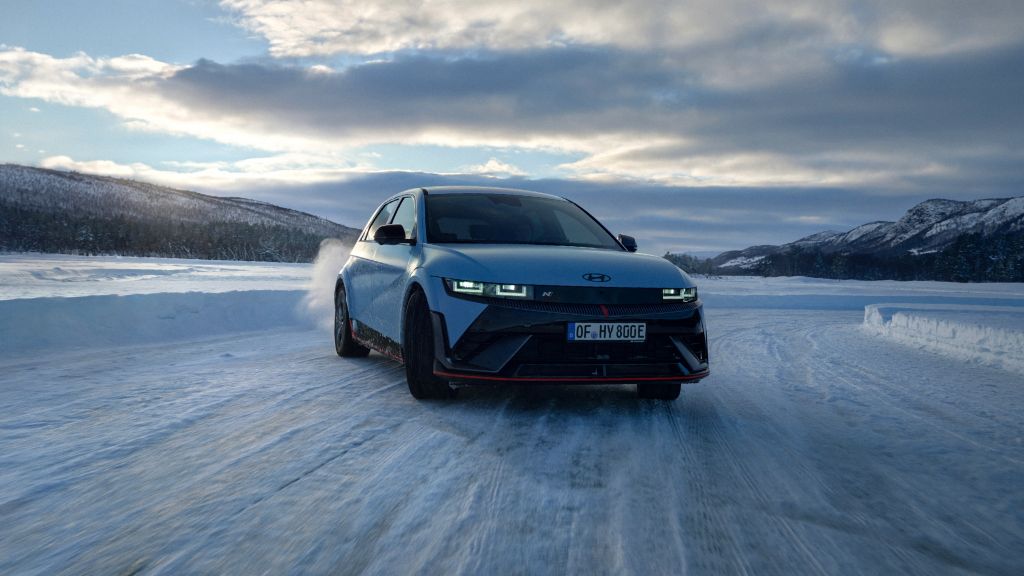Electric cars are fast. Shockingly fast. They hit you with a silent surge of torque, the relentless pull leaving your brain struggling to catch up with your eyeballs. It's undeniably cool, but also a little... clinical. Enter the Hyundai Ioniq 5 N, the Korean automaker's attempt to restore the balance and inject a dose of messy, visceral, and old school fun into the EV experience.
The Ioniq 5 was already a quirky standout in the EV world, with its retro-futuristic styling and spacious, tech-filled interior. The N version turns things up to 11. Sure, it's got more power (a whole lot more), sharper handling, and all the requisite sporty bits. But the star of the show might just be its transmission. Or rather, the thing that isn't a transmission.
You see, Hyundai's engineers have done something rather clever, and a bit controversial: They've given the Ioniq 5 N a fake gearbox. Not a physical one with gears and clutches, but a software-programmed simulation of an 8-speed dual-clutch automatic.

Why Mess With Perfection?
Let's be honest – EVs don't need gearboxes. Their motors deliver power in one continuous whoosh, with no shifting required. It's part of what makes them so brutally efficient. But for old-school driving enthusiasts, there's something satisfying about the rhythmic changes of a traditional automatic, the feel of the engine winding up and down.
This is where Hyundai's "N e-Shift" system comes in. At its core, it's still the same single-speed EV powertrain, but the software cleverly manipulates power delivery to mimic the feel of gear changes. There's even simulated engine braking and a fuel cut-off when you bounce off the digital rev limiter. Wild, right?

Benefits of N e-Shift on the 2025 Hyundai Ioniq 5 N:
- Engaged Driving Experience: The simulated gear changes and engine braking add a layer of drama and interaction often missing in EVs.
- Customizable Control: Drivers can choose the intensity of simulated shifts and engine braking through drive modes and paddle shifters, creating a personalized experience.
- Appealing to Traditional Performance Enthusiasts: N e-Shift offers a familiar feel for drivers who appreciate the connection of a traditional automatic transmission.
The Art of the Fake-Out
So, how does it actually work? Hyundai's keeping its secret sauce under wraps, but as car nerds, we can make some educated guesses. Likely, it's all about manipulating the power delivery of the electric motors, creating artificial pauses and surges that feel sort of like shifts.
And that's the point. The Ioniq 5 N isn't trying to fool you into thinking it's a gas-guzzler. Hyundai knows it's an EV and leans into that fact. Instead, this fake transmission tech is not meant to impress the true car enthusiast who cherishes the smells, sounds, and vibrations of a V8, instead, it's all about creating a bridge for drivers who love the feel of a traditional performance car but are ready to embrace the electric future.
The Ioniq 5 N even has paddle shifters, not to actually change gears (there aren't any!), but to let you play along with the illusion, controlling the intensity of the simulated shifts and engine braking. Add in synthesized engine noises pumped through the speakers, and you've got a surprisingly convincing EV theater performance.

The Pros and the Cons
Now, let's get real. Does this make the Ioniq 5 N objectively faster? Nope. In fact, there's an argument that it probably makes it a tiny bit slower, as truly seamless power delivery is an EV's forte. But cars aren't always about pure numbers. The simulated gearbox makes the Ioniq 5 N more engaging, more playful, and more characterful than your average electric hot hatch.
Purists will scoff – and hey, that's fair. There's a joy in the simplicity and relentless torque of a "real" EV. But for those craving a dash of old-school fun in their futuristic ride, Hyundai might just be onto something.

Considerations and Potential Drawbacks of the Ioniq 5 N:
- Simulated Experience: N e-Shift doesn't alter the car's core single-speed nature. It's a theatrical performance, not a true gearbox.
- Potential Efficiency Loss: Some argue the system might introduce slight inefficiencies compared to pure, seamless power delivery of a traditional EV.
- Unnecessary Complexity? Purists might consider N e-Shift unnecessary, preferring the raw simplicity and relentless torque of a true EV.
The Verdict
So, does Hyundai's transmission trickery actually work? Surprisingly, yes. Is it a bit silly? Absolutely. But that silliness is kind of the point. Driving the Ioniq 5 N in its most aggressive modes, complete with the synthesized soundtrack, the simulated shifts do add a layer of drama and engagement missing from many EVs. It won't fool anyone who's spent time behind the wheel of a performance car, but it gets closer than you might expect.
Where this tech shines is in its adjustability. Don't like fake gear shifts? Turn them off entirely, and you're back to that seamless EV surge. Want to dial up the intensity? Paddle shifters and various drive modes let you customize the experience. It's a choose-your-own-adventure for driving nerds.
The Ioniq 5 N's "N e-Shift" system won't be for everyone. But it shows Hyundai isn't afraid to experiment or have a bit of fun, even when catering to the performance crowd. In a world where every new EV seems focused on maximum efficiency and mind-numbing acceleration figures, the Ioniq 5 N dares to be different. And that, even more than its simulated gearbox, might just be its biggest win.
Click on the red link below to write your comment and express your opinion on this subject.
Author Bio
Bhavik Sreenath is an automotive expert, writer, and founder of Motolog Studio. With a Master's in Automotive Journalism and experience in publications like Bodyshop Magazine, he delivers compelling stories about the cars we love. From designing magazine layouts to reporting on eco-conscious practices, he brings a multifaceted perspective to automotive writing. His experience in Automotive Journalism makes him a vocal voice for car enthusiasts and industry insiders. Follow Bhavik on X, LinkedIn, Instagram, and Facebook, to stay in touch and up-to-date with the latest EV and battery development news.












